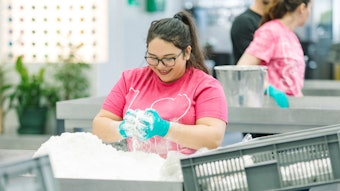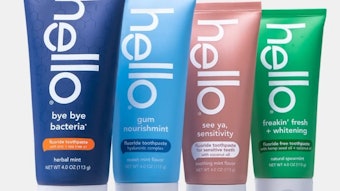- Secondary oral care products are still not used regularly outside the most developed oral care markets, but do have significant growth opportunities.
- For toothpaste, value growth has been driven by trading up to more value-added products, such as whitening.
- Age segmentation is a major growth avenue being pursued in a relatively mature category, with child-orientated products, in particular, increasing in popularity.
- The whitening category in a number of developed markets is considered to be nearing saturation.
- Persuading consumers globally to trade up from basic products will be a key driver of future growth.
Oral care experienced modest yet stable growth from 2004–2009, chalking up a compound annual growth rate of 4% over that period. In fact, the otherwise mature and saturated category registered only a slight dip in value growth to 4% in 2009, down from 5% the previous year. This was largely thanks to a continued push toward value-added products as well as oral care’s enviable status as one of the most essential categories within beauty and personal care.
Basic Products Outperform Secondary Products
Basic oral care products (toothpaste and toothbrushes) have proven far more resilient to the economic crisis than secondary oral care, which is comprised of mouthwashes/dental rinses, mouth fresheners, dental floss, denture care and tooth whiteners. Many of these products are still not used regularly outside the most developed oral care markets, but they do have significant growth opportunities as toothbrush and toothpaste usage becomes more common among very low-income consumers.
Strong Potential for Toothbrushes
In some emerging markets, such as Venezuela and South Africa, toothbrush penetration itself is already comparatively high, with many consumers already brushing their teeth on a daily basis. Hence, growth has been driven by more low-income consumers being able to afford to buy these products more frequently. In other markets, notably Egypt, where per capita spend on toothbrushes was just 0.2 units in 2009 (i.e. only one in four consumers purchased a toothbrush in 2009), there remains a lack of awareness of general oral hygiene, and growth is being driven by brand owners’ attempts to educate consumers as to the importance of oral health.
Many Emerging Markets Yet to Realize Major Growth in Toothpaste
Toothpaste performance is in contrast with toothbrushes, with most low per capita countries still not seeing strong growth. India was the only low per capita country with strong value growth in 2009.
For toothpaste, value growth has been driven by trading up to more value-added products, such as whitening and children’s toothpaste. Countries with low per capita values that have not taken off include certain North African countries such as Morocco, which had one of the lowest uses of toothpaste globally, at just 0.03 liters per capita in 2009.
This is because, unlike other emerging regions where toothpaste usage has been growing, competition in North Africa is still strong from the traditional miswak, a twig known for its effectiveness in cleaning teeth and gums. This situation will likely remain as the World Health Organization has recommended its use for oral care. Studies show that its effectiveness is comparable to other oral disinfectants and anti-plaque agents if used in high concentrations.
Little Evidence of Cutting Back in Mature Markets
Even in times of economic difficulty in mature Western markets, demand for basic oral care products has not been sacrificed. Volume growth was sustained because very few consumers were willing to stop cleaning their teeth in order to save money. This also resulted in consistent value growth for basic oral care of 5% in both 2008 and 2009. In contrast, secondary oral care products have been hit harder by the recession.
Compared to the promising 7% value growth achieved in 2007, value growth in 2008 slowed considerably to 4%, and 2009 value growth slowed further to just 3%. The effects of this on the oral care category overall were cushioned somewhat by the fact that these secondary products accounted for just 20% of total oral care value sales in 2009.
Power Toothbrushes Take Backseat During Recession
Manual toothbrushes continue to dominate sales, accounting for 70% of global toothbrush value sales in 2009. Power toothbrushes, however, grew in popularity during the 2004–2009 period. Before the economic crisis, growth had been robust compared to manual versions. Consumers were trading up due to a perception that power toothbrushes are more effective than manual ones.
However, manual toothbrushes proved to be more resilient to the tough economic conditions, registering 4% value growth in 2009 compared to 2% for power toothbrushes. While many markets continued to see robust growth, price remains a major obstacle in emerging countries. That said, there is still a growing trend toward battery toothbrushes, if not yet electric toothbrushes, in developing markets.
Age Segmentation Helps Drive Sales in Mature Markets
Age segmentation is a major growth avenue being pursued by brand owners in a relatively mature category, with child-orientated products, in particular, increasing in popularity. As brands seek ways to sustain growth for toothpaste, products catering to children are showing potential.
Future opportunities for children’s toothpaste clearly exist in developing countries with high birth rates, but many consumers are not yet at the level of disposable income where they will buy separate toothpaste for their children at a premium price. In contrast, even developed countries with a low birth rate have shown strong growth in baby- and child-orientated oral care products, as parents are able to devote more resources to their children. For example, Italy and Germany are among those low birth rate countries where children’s toothpaste has done well. In Germany, there is already further segmentation in terms of toothpaste for babies and children. Colgate-Palmolive recently introduced three highly segmented child-variant toothpastes: Smiles 0–2, Smiles 2–6 and Smiles 6+ under the Colgate brand. It also introduced junior toothpaste under the Elmex brand, while rival Unilever did the same for the Signal brand.
Mexico, meanwhile, is in a contrasting situation. The birth rate is high but children’s toothpaste is not yet booming, accounting for less than 1% of toothpaste sales in 2009. Brands are, nonetheless, already making inroads with children’s products, mostly battery toothbrushes for children. The potential for children’s toothpaste is, therefore, still high.
Global Success of Whitening Toothpaste?
Whitening toothpaste is one of the most popular toothpaste types, with products present in more than 50 countries as of 2009.
The products have a long tradition, and are accepted as the norm in many developed markets. For example, 39% of all toothpaste sold in Canada in 2009 had whitening properties. The whitening category in a number of developed markets, however, is considered to be nearing saturation. In response, brand owners are increasingly focusing on combining the whitening effect with other popular toothpaste properties, such as care for sensitive teeth, one example being Sensodyne’s Gentle Whitening variant.
BRIC Fuelling Global Value Growth
Brazil, Russia, India and China are significant contributors to global oral care growth, with the four countries showing a combined $589 million value increase 2008–2009. Developing countries, including the BRICs, have played a major role in sustaining the growth of basic oral care. Increasing frequency of toothpaste and toothbrush usage has driven this growth. Stronger hygiene awareness has encouraged more frequent brushing of teeth, the usage of more toothpaste when brushing and raised the frequency of toothbrush replacement. In addition, growing middle-class consumer bases in all four countries have further driven demand for secondary oral care products.
Germany and Spain: The Most Dynamic Mature Markets
While developing countries feature strongly among the fastest-growing markets, major developed countries Germany and Spain are still among the fastest-growing in oral care. The high population of these countries is the main driver, despite low growth in percentage terms.
India and Venezuela: The Top Hot Spots for Future Growth
Rural consumers in India (roughly 70% of the country’s population) are set to drive growth, thanks to rising awareness of the importance of oral hygiene and improving income levels. Consumers have been switching from traditional, homemade solutions such as datun and neem leaves to using toothbrushes and toothpaste. Meanwhile, urban consumers are changing their toothbrushes more regularly than before, in line with dentists’ recommendations of every three months, due to rising oral hygiene awareness. Venezuela currently has very low per capita usage of toothbrushes—on average just one in two consumers purchased a toothbrush in 2009—and toothpaste, but there are very high growth rates in both categories (38% value growth for toothbrushes and 40% for toothpaste in 2009). Growth has been driven by a rise in disposable income among low-income consumers, meaning that more people are able to afford to buy and replace basic oral care products more frequently.
Trading Up; Increasing Frequency of Use Key
Persuading consumers globally to trade up from basic products, such as from manual toothbrushes to power toothbrushes or standard toothpaste to whitening toothpaste, will be a key driver of future growth—along with increasing frequency of usage and, in turn, purchase. The push to ensure consumers brush their teeth twice a day will also be instrumental in driving volume sales. New product development is likely to focus on offering consumers better efficacy in removing plaque, with more launches such as Aquafresh’s foaming toothpaste, introduced in 2010 and aimed at preventing consumer trade down to less-expensive private label products in mature markets.
Outlook: Recovery Ahead for Both Basic and Secondary Products
The oral care category is set to grow globally by $3.5 billion in 2009–2014; basic products will account for the lion’s share of this growth. Toothpaste and toothbrushes will account for approximately $2.8 billion of this (79%). Secondary products will also bounce back to growth, with mouthwashes/dental rinses contributing the best performance (forecast for a $531 million increase in 2009–2014), and other products rising more steadily. Segmentation, efficacy, cosmetic benefits (such as whitening), a focus on oral health and further consumer segmentation will be the key strategies for future growth in the global oral care market.
Carrie Lennard is a research analyst at Euromonitor International.





![Burst founder Hamish Khayat says, 'The kids’ brush is a great example [of our product development philosophy]: the biggest problem with existing brushes was that brush heads aren’t curved at the end, so they can’t reach the rear molars. So, you curve the head and you solve that problem.' Pictured are variants of the BurstKids Sonic Toothbrush.](https://img.gcimagazine.com/files/base/allured/all/image/2022/05/BURSTkids_Sonic_Toothbrushes.6287fd790c577.png?auto=format%2Ccompress&fit=crop&h=191&q=70&w=340)




